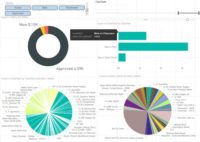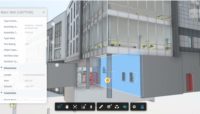
Building Information Modeling (BIM) has revolutionized design and construction by streamlining collaboration, improving efficiency, and reducing costs. However, as contractors and designers continue to adopt BIM practices, the need for enhanced interoperability and effective handling of data-rich 3D models becomes increasingly important.
Interoperability refers to the seamless exchange of information between different BIM software applications and platforms, enabling the smooth exchange and utilization of data.
A study conducted by PlanGrid and management consultant FMI Corp. of nearly 600 construction leaders, calculated that the time spent fixing mistakes, looking for project data, and managing conflict resolution and interoperability issues accounted for $177.5 billion in labor costs per year in the U.S. alone. The study also found rework caused by miscommunication and inaccurate or inaccessible information could cost U.S. contractors and construction managers more than $31 billion if left unaddressed.
Efforts are being made to combat interoperability challenges through the adoption of open BIM standards and the promotion of discussions among different stakeholder groups with the goal of creating an optimal and flexible environment that mitigates issues, fosters collaboration, and maximizes the sharing of information throughout the entire project lifecycle.
Here are some suggestions for enhancing interoperability and working with data-rich 3D models. By considering these factors, owners and design and construction teams can enhance interoperability and derive maximum value from BIM.
Identify Project Data Sharing Requirements
Interoperability is not just about sharing files—it's about understanding what information is valuable to different stakeholders throughout the entire project lifecycle. Key stakeholders, including owners, architects, engineers, construction professionals, and end users must engage in conversations early in the design process to determine what data needs to be exchanged and what information is necessary for each party. This includes identifying the desired outcomes, information handover points, and the tools and protocols required to meet these data or technology-driven goals defined typically by the stakeholders at the beginning of the project to drive collaboration and project efficiency. Owners may want access to critical infrastructure specifications at the end of the project to support operations and maintenance protocols. By identifying what each team member needs early in the process, stakeholders can avoid information loss and make certain the right information is shared at the right time.
‘Right-Sizing’ Data
During Autodesk CEO Andrew Anagnost’s Future of Construction Speech at Autodesk University in 2022, two references resonated: 95% of all work will take place on a cloud-based platform and approximately 95% of data gathered and generated during the design of a project is discarded or unused, according to FMI. This raises important questions regarding the necessity of creating overly detailed BIM. Data-rich, 3D models offer a wealth of information. However, it is essential to strike a balance between including relevant data and avoiding information overload. Stakeholders should evaluate the downstream use cases for each piece of information and make certain only necessary data is incorporated into the models. Right-sizing the information assures models remain efficient, manageable, and usable throughout the project lifecycle. This evaluation should be part of the planning process, involving all relevant parties to determine the optimal level of data inclusion.
Monopoly: Good for the Board Game, Bad for File Formats
The goal of enhancing interoperability is to not restrict stakeholders to a single file format but enable seamless data exchange across multiple formats. It is crucial to promote flexibility and avoid monopolizing a particular file format, as this can hinder collaboration and limit the use of diverse software tools that best suit different project requirements. Instead, stakeholders should focus on defining data exchange protocols and selecting file formats based on the authoring programs used by different stakeholders. This approach allows for greater compatibility and promotes a more inclusive and collaborative environment.
Remove Barriers and Constraints
Interoperability requires open communication channels, access to software, training, equipment, and licensing. Stakeholders should identify and remove barriers that hinder effective collaboration and information sharing. This includes addressing challenges related to file format compatibility, export protocols, hardware requirements, and sharing methodologies. Barriers and constraints, such as limited access to software, training, equipment, or licensing, should be removed to enhance interoperability. By ensuring all stakeholders have the necessary resources and support, project teams can foster success.
On a recent project involving a manufacturer’s administrative office building, the owner expressed the desire to be actively involved in the design process but lacked the technical infrastructure required to work with BIM. The design team removed this constraint by leveraging Autodesk Construction Cloud, which is accessed through a web browser and does not require additional software. This allowed the client to easily participate in the design review process, enabling real-time feedback and helping them understand how their decisions impacted the project timeline. This approach effectively bridged the gap between the design team and the client, promoting transparency, interoperability, and enhancing the decision-making process.
Challenges in File Formats and Conversions
One of the significant pain points in a data-rich environment is dealing with file sizes and conversions. Understanding the authoring platforms, determining the appropriate file formats for data exchange, and coordinating unit systems and software compatibility are essential steps before commencing the design process. Failure to address these issues adds significant time and effort to the coordination process, impacting computer performance and model efficiency.
This was the case on a large industrial expansion to house a new manufacturing line. The process design file for the machinery was received as a single, unwieldy file. To facilitate integration between the process design and the manufacturing space, the project team divided the file into smaller files. Further optimizing the integration process, the team employed an additional technique of pixelating the smaller file fragments.
The reduced file size made it more convenient to share and collaborate, while the pixelated representation facilitated effective coordination between the process design and overall construction. Utilizing this practical approach ensured efficient communication among the stakeholders, contributing to the project’s successful completion.
Foster Trust and Address Emerging Technology
Establishing trust is crucial for effective data management and interoperability. Stakeholders must have confidence in the accuracy, timeliness, and relevance of shared data. As the industry embraces emerging technologies like Artificial Intelligence, addressing concerns about data integrity and the role of humans in keeping data up to date has become essential. Transparency in data entry and updating processes, along with industry-wide standards and certifications, can help build trust among stakeholders and facilitate better collaboration.
Considerations for Platform Selection and Cost Efficiency
The choice of software platforms and their associated costs can significantly impact interoperability and project efficiency. Different stakeholders may have preferences for specific platforms based on their project role or industry standards. However, supporting multiple platforms requires additional training, reduces efficiency, and increases costs. It is important to select a platform carefully, considering factors such as licensing discounts, software compatibility, and long-term investments in hardware infrastructure.
Common Data Exchange Formats
Standardization of data exchange formats is crucial for achieving interoperability. Encouraging the use of open standards, such as Industry Foundation Classes and Construction Operations Building Information Exchange (COBie), assures data can be shared accurately and consistently across different software applications. Supporting these formats allows for improved collaboration, reduces data loss, and enhances the compatibility of BIM. The use of cloud-based platforms, project management tools, and Common Data Environments (CDEs) facilitates real-time collaboration and data sharing, providing all parties with access to the most up-to-date information. Open application programming interfaces (APIs) play a critical role in enabling interoperability between software applications. Virtual design practitioners or AEC Developers can investigate available integration plug-ins that can facilitate seamless data exchange between applications like Revit and cost estimation, scheduling, or facilities maintenance applications.
Industry Collaboration and Standardization
Enhancing interoperability requires collective efforts from design and construction. Collaborative initiatives involving software developers, industry organizations, and regulatory bodies can drive the development of common standards and guidelines. For example, National Institute of Building Sciences BIM Program Executive Director Johnny Fortune was recently featured on the organization’s Future Construct podcast, where he discussed BIM coordination solutions for AEC. Additionally, a report from Autodesk and FMI, Harnessing the Data Advantage in Construction, highlights the surprising cost of inaction related to managing project data. The sharing of interoperability best practices by these organizations stands to significantly improve the industry's ability to implement and leverage BIM effectively.
Training and Education
Investing in training and education is crucial for fostering interoperability in the design and construction industry. Offering comprehensive training programs that focus on BIM workflows, data exchange protocols, and software integration empowers professionals to navigate interoperability challenges effectively. Educational institutions, industry associations, and software vendors can play a significant role in providing training resources and developing a skilled workforce capable of utilizing BIM to its fullest potential.
In Conclusion
Interoperability is a fundamental component of the design and construction process, and in the context of BIM, it plays a vital role in facilitating collaboration, data sharing, and effective project management. With the goal of optimizing the sharing of information throughout a project's lifecycle, interoperability helps build trust, streamline processes, and improve client engagement. By implementing the strategies outlined above, the design and construction industry can unlock the full potential of BIM, improve efficiency, and deliver successful projects that meet the evolving needs of owners.
Lauren Collier, Associate AIA, is the Director of Project Technology and a Senior Associate at SSOE Group, an internationally ranked architecture and engineering firm. Her creative passion lies in Lean, continuous improvements, and innovative model / data use solutions for design and construction operations. Lauren leads a diverse group of VDC technology leaders, software DevOps, and model managers whose focus is implementing new and innovative technologies, processes, and best practices in design and construction. She can be reached in SSOE’s Toledo, Ohio, office at lcollier@ssoe.com.






